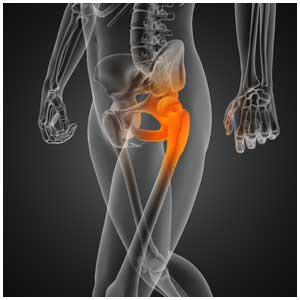Hip Anatomy
|
|
The hip joint
functions as one of the most important
joints in the human body. Designed for
both mobility and stability, the hip
allows the entire lower extremity to move
in three planes of motion, while providing
an important shock absorption function to
the torso and upper body. The hip is a
ball and socket joint, uniting the femur
(thigh bone) with the pelvis. As a result
of this configuration, the leg moves
forwards and backwards, side to side, and
rotates to the right and left.
1) BONES -
TThe pelvis
features two cup-shaped depressions called
the acetabulum, one on either side of the
body. The femur, or thigh bone, is the
longest bone in the body and connects to
the pelvis at the hip joint. The head of
the femur, shaped like a ball, fits
tightly into the acetabulum, forming the
ball and socket joint of the hip.
2) CARTILAGE -
Embedded within
the acetabulum of the pelvis lies an
important structure known as articular
cartilage; this cartilage has two very
important functions. First, the smooth,
low friction surface of the cartilage
allows the hip joint to move freely in all
planes of movement. Second, the articular
cartilage cushions the hip during weight
bearing activities, providing an important
shock absorption function to the entire
lower extremity.
3) LIGAMENTS -
The hip joint
also features a complex system of
ligaments that provide stability for the
pelvis and lower extremity. The ligaments
of the hip joint connect the femur to the
pelvis and are essential to keeping the
hip from moving outside of its normal
planes of movement.
4) MUSCLES -
The muscles of
the hip joint have dual responsibilities.
They provide the dynamic functions
necessary to raise and lower the lower
extremity as well as the stabilizing
functions required during standing,
walking, or other weight-bearing
exercises. This complex system of muscles
works synergistically to provide the power
for the hip to move in all directions, as
well as to stabilize the entire lower
extremity during weight bearing
activities.
|
|
|
 Arthritis of the hip
is a disease which wears away the cartilage
between the femoral head and the acetabulum, the
two bones will scrape against each other, raw bone
on raw bone. When this happens, the joint becomes
pitted, eroded and uneven. The result is pain,
stiffness and instability. In some cases, motion
of the leg may be greatly restricted. Arthritis of the hip
is a disease which wears away the cartilage
between the femoral head and the acetabulum, the
two bones will scrape against each other, raw bone
on raw bone. When this happens, the joint becomes
pitted, eroded and uneven. The result is pain,
stiffness and instability. In some cases, motion
of the leg may be greatly restricted.
OSTEOARTHRITIS
Osteoarthritis, which
is the most common form of arthritis in the United
States; it is degenerative and although it most
often occurs in patients over the age of 50, it
can occur at any age, especially if the joint is
in some way damaged.
It is usually confined to the large weight-bearing
joints of the lower extremities, including the
hips and knees, but may affect the spine and upper
extremity joints, too. Patients with
osteoarthritis often develop large bone spurts, or
osteophytes, around the joint, further limiting
motion.
CAUSES
Osteoarthritis of the
hip is a condition commonly referred to as "wear
and tear" arthritis. Although the degenerative
process may accelerate in persons with a previous
hip injury, many cases of osteoarthritis occur
when the hip simply wears out. Some experts
believe there may be a genetic predisposition in
people who develop osteoarthritis of the hip.
Abnormalities of the hip due to previous fractures
or childhood disorders may also lead to a
degenerative hip. Osteoarthritis of the hip is the
most common cause for total hip replacement
surgery.
SYMPTOMS
The first and most
common symptom of osteoarthritis is pain in the
hip or groin area during weight bearing activities
such as walking. People with hip pain usually
compensate by limping, or reducing the force on
the arthritic hip. As a result of the cartilage
degeneration, the hip loses its flexibility and
strength, and may result in the formation of bone
spurs. Finally, as the condition worsens, the pain
may be present all the time, even during non
weight-bearing activities.
TRTEATMENT
Before considering
total hip replacement surgery, your doctor and you
may try various non-surgical therapies. An
appropriate weight reduction program may be
beneficial in decreasing force across the hip
joint. However, weight reduction can be difficult
for people with hip arthritis since the arthritis
pain precludes them from increasing their activity
and burning calories. An exercise program may be
instituted to improve the strength and flexibility
of the hip and the other lower extremity joints.
Lifestyle and activity modification may be
undertaken in an attempt to minimize the
activities that are associated with hip pain.
Finally, various medications such as non-steroidal
anti-inflammatory drugs (NSAIDs) and/or
nutritional supplements (Chondroitin/Glucosamine)
to reduce pain and inflammation associated with
the disease may be considered.
Assistive devices like a cane or a crutch can help
to reduce the force transmitted through the hip
joint during walking and thereby may help to
decrease hip arthritis pain. If non-surgical
treatment is unsuccessful, you and your surgeon
may decide that a total hip replacement is the
best available treatment option.
|